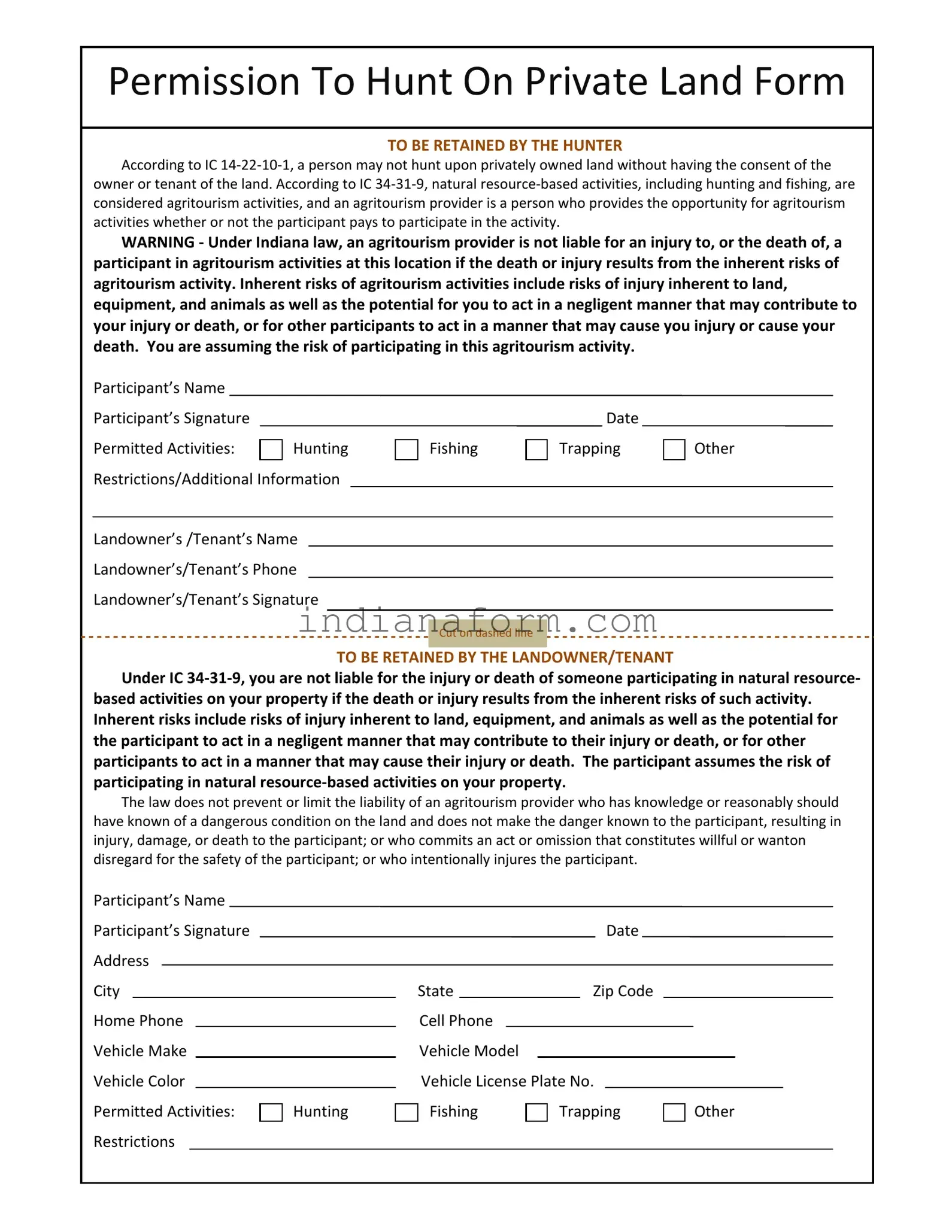
Permission To Hunt On Private Land Form
TO BE RETAINED BY THE HUNTER
According to IC 14‐22‐10‐1, a person may not hunt upon privately owned land without having the consent of the owner or tenant of the land. According to IC 34‐31‐9, natural resource‐based activities, including hunting and fishing, are considered agritourism activities, and an agritourism provider is a person who provides the opportunity for agritourism activities whether or not the participant pays to participate in the activity.
WARNING ‐ Under Indiana law, an agritourism provider is not liable for an injury to, or the death of, a participant in agritourism activities at this location if the death or injury results from the inherent risks of agritourism activity. Inherent risks of agritourism activities include risks of injury inherent to land, equipment, and animals as well as the potential for you to act in a negligent manner that may contribute to your injury or death, or for other participants to act in a manner that may cause you injury or cause your death. You are assuming the risk of participating in this agritourism activity.
Participant’s Name
Participant’s Signature
Permitted Activities: 
 Hunting Restrictions/Additional Information
Hunting Restrictions/Additional Information
Landowner’s /Tenant’s Name
Landowner’s/Tenant’s Phone
Landowner’s/Tenant’s Signature
Cut on dashed line
TO BE RETAINED BY THE LANDOWNER/TENANT
Under IC 34‐31‐9, you are not liable for the injury or death of someone participating in natural resource‐ based activities on your property if the death or injury results from the inherent risks of such activity. Inherent risks include risks of injury inherent to land, equipment, and animals as well as the potential for the participant to act in a negligent manner that may contribute to their injury or death, or for other participants to act in a manner that may cause their injury or death. The participant assumes the risk of participating in natural resource‐based activities on your property.
The law does not prevent or limit the liability of an agritourism provider who has knowledge or reasonably should have known of a dangerous condition on the land and does not make the danger known to the participant, resulting in injury, damage, or death to the participant; or who commits an act or omission that constitutes willful or wanton disregard for the safety of the participant; or who intentionally injures the participant.
|
|
|
|
|
|
|
|
|
|
|
|
|
|
|
|
|
|
|
|
|
|
Participant’s Name |
|
|
|
|
|
|
|
|
|
|
|
|
|
|
|
|
|
Participant’s Signature |
|
|
|
|
|
|
|
|
|
|
Date |
|
|
|
Address |
|
|
|
|
|
|
|
|
|
|
|
|
|
|
|
|
|
|
|
|
|
|
|
|
|
|
|
|
|
|
|
|
|
|
|
|
|
|
|
|
City |
|
|
|
|
State |
|
|
|
Zip Code |
|
|
|
|
Home Phone |
|
|
|
|
Cell Phone |
|
|
|
|
|
|
|
|
|
|
|
|
Vehicle Make |
|
|
|
|
Vehicle Model |
|
|
|
|
|
|
|
|
|
|
Vehicle Color |
|
|
|
|
Vehicle License Plate No. |
|
|
|
|
|
|
|
Permitted Activities: |
|
Hunting |
|
Fishing |
|
|
Trapping |
|
|
Other |
|
|
|
|
|
Restrictions |
|
|
|
|
|
|
|
|
|
|
|
|
|
|
|
|
|
|



 Hunting Restrictions/Additional Information
Hunting Restrictions/Additional Information